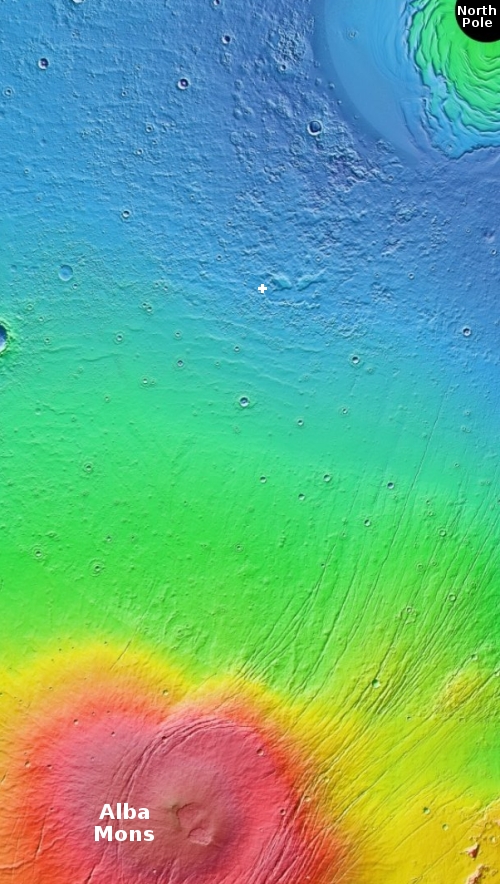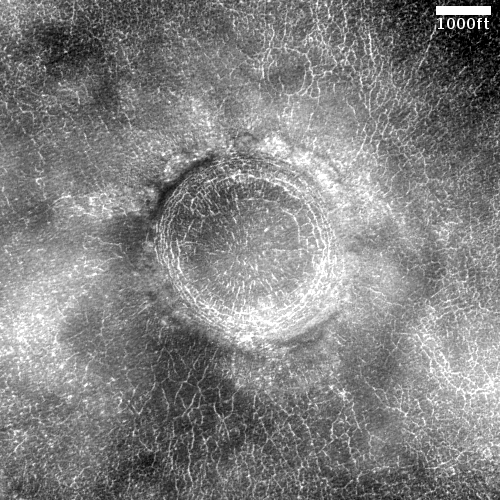Fractured crater close to the Phoenix lander on Mars
Cool image time! The photo to the right, cropped to post here, was taken on May 3, 2021 by the high resolution camera on Mars Reconnaissance Orbiter (MRO). It shows a remarkably fractured crater that lies only a few miles to the southeast of where the now-inactive Phoenix lander put down back in 2008, at the very high latitude of 69 degrees north.
Phoenix was purposely sent to this high latitude to find out what the ground and atmosphere was like there. It found the following:
Phoenix’s preliminary science accomplishments advance the goal of studying whether the Martian arctic environment has ever been favorable for microbes. Additional findings include documenting a mildly alkaline soil environment unlike any found by earlier Mars missions; finding small concentrations of salts that could be nutrients for life; discovering perchlorate salt, which has implications for ice and soil properties; and finding calcium carbonate, a marker of effects of liquid water.
Phoenix findings also support the goal of learning the history of water on Mars. These findings include excavating soil above the ice table, revealing at least two distinct types of ice deposits; observing snow descending from clouds; providing a mission-long weather record, with data on temperature, pressure, humidity and wind; observations of haze, clouds, frost and whirlwinds; and coordinating with NASA’s Mars Reconnaissance Orbiter to perform simultaneous ground and orbital observations of Martian weather.
Below is an overview map showing the location of both this crater and the Phoenix lander.

The white cross indicates the location of both Phoenix and this crater. The giant shield volcano Alba Mons, about 1,500 miles to the south, lies north of the Tharsis Bulge where Olympus Mons and the line of three other giant volcanoes are found.
Because the fractured crater is so close to Phoenix’s landing site, the ground and atmospheric conditions should be quite similar, and can act to help explain what we see. Thus, the white material in the cracks is probably frost — both water ice and dry ice — since the picture was taken in the spring, and the Sun is only beginning to warm the surface.
The cracked surface suggests two possibilities to my ignorant eye. One, the impact hit a hard surface (slab rock) lying on top of softer material (ice). Thus, the ground cracked. More likely however these fractures occurred much later, after the impact, and reflect the changes caused by the seasonal fluctuations of temperate and atmosphere. The higher salt content in the soil could also help cause these kinds of cracks, as conditions can sometimes cause it to push up from below.
The full image reinforces this second hypothesis. The crater is surrounded by an apron of material, also fractured, that is probably melted and refrozen ice, splashed in a wave by the original impact.
On Christmas Eve 1968 three Americans became the first humans to visit another world. What they did to celebrate was unexpected and profound, and will be remembered throughout all human history. Genesis: the Story of Apollo 8, Robert Zimmerman's classic history of humanity's first journey to another world, tells that story, and it is now available as both an ebook and an audiobook, both with a foreword by Valerie Anders and a new introduction by Robert Zimmerman.
The print edition can be purchased at Amazon or from any other book seller. If you want an autographed copy the price is $60 for the hardback and $45 for the paperback, plus $8 shipping for each. Go here for purchasing details. The ebook is available everywhere for $5.99 (before discount) at amazon, or direct from my ebook publisher, ebookit. If you buy it from ebookit you don't support the big tech companies and the author gets a bigger cut much sooner.
The audiobook is also available at all these vendors, and is also free with a 30-day trial membership to Audible.
"Not simply about one mission, [Genesis] is also the history of America's quest for the moon... Zimmerman has done a masterful job of tying disparate events together into a solid account of one of America's greatest human triumphs."--San Antonio Express-News
Cool image time! The photo to the right, cropped to post here, was taken on May 3, 2021 by the high resolution camera on Mars Reconnaissance Orbiter (MRO). It shows a remarkably fractured crater that lies only a few miles to the southeast of where the now-inactive Phoenix lander put down back in 2008, at the very high latitude of 69 degrees north.
Phoenix was purposely sent to this high latitude to find out what the ground and atmosphere was like there. It found the following:
Phoenix’s preliminary science accomplishments advance the goal of studying whether the Martian arctic environment has ever been favorable for microbes. Additional findings include documenting a mildly alkaline soil environment unlike any found by earlier Mars missions; finding small concentrations of salts that could be nutrients for life; discovering perchlorate salt, which has implications for ice and soil properties; and finding calcium carbonate, a marker of effects of liquid water.
Phoenix findings also support the goal of learning the history of water on Mars. These findings include excavating soil above the ice table, revealing at least two distinct types of ice deposits; observing snow descending from clouds; providing a mission-long weather record, with data on temperature, pressure, humidity and wind; observations of haze, clouds, frost and whirlwinds; and coordinating with NASA’s Mars Reconnaissance Orbiter to perform simultaneous ground and orbital observations of Martian weather.
Below is an overview map showing the location of both this crater and the Phoenix lander.

The white cross indicates the location of both Phoenix and this crater. The giant shield volcano Alba Mons, about 1,500 miles to the south, lies north of the Tharsis Bulge where Olympus Mons and the line of three other giant volcanoes are found.
Because the fractured crater is so close to Phoenix’s landing site, the ground and atmospheric conditions should be quite similar, and can act to help explain what we see. Thus, the white material in the cracks is probably frost — both water ice and dry ice — since the picture was taken in the spring, and the Sun is only beginning to warm the surface.
The cracked surface suggests two possibilities to my ignorant eye. One, the impact hit a hard surface (slab rock) lying on top of softer material (ice). Thus, the ground cracked. More likely however these fractures occurred much later, after the impact, and reflect the changes caused by the seasonal fluctuations of temperate and atmosphere. The higher salt content in the soil could also help cause these kinds of cracks, as conditions can sometimes cause it to push up from below.
The full image reinforces this second hypothesis. The crater is surrounded by an apron of material, also fractured, that is probably melted and refrozen ice, splashed in a wave by the original impact.
On Christmas Eve 1968 three Americans became the first humans to visit another world. What they did to celebrate was unexpected and profound, and will be remembered throughout all human history. Genesis: the Story of Apollo 8, Robert Zimmerman's classic history of humanity's first journey to another world, tells that story, and it is now available as both an ebook and an audiobook, both with a foreword by Valerie Anders and a new introduction by Robert Zimmerman.
The print edition can be purchased at Amazon or from any other book seller. If you want an autographed copy the price is $60 for the hardback and $45 for the paperback, plus $8 shipping for each. Go here for purchasing details. The ebook is available everywhere for $5.99 (before discount) at amazon, or direct from my ebook publisher, ebookit. If you buy it from ebookit you don't support the big tech companies and the author gets a bigger cut much sooner.
The audiobook is also available at all these vendors, and is also free with a 30-day trial membership to Audible.
"Not simply about one mission, [Genesis] is also the history of America's quest for the moon... Zimmerman has done a masterful job of tying disparate events together into a solid account of one of America's greatest human triumphs."--San Antonio Express-News


